The next-gen MacBook Pro with Retina Display Review
by Anand Lal Shimpi on June 23, 2012 4:14 AM EST- Posted in
- Mac
- Apple
- MacBook Pro
- Laptops
- Notebooks
General Performance
The Retina MacBook Pro can complete a full boot from power off to usable desktop in just over 17 seconds. It’s a hair faster than last year’s MacBook Airs, a bit quicker than the old SSD equipped MacBook Pro, and night and day compared to any Mac with a hard drive. Four years ago I said that Solid State Drives were the single biggest upgrade you could do for your computer, and it couldn’t be any more true today.
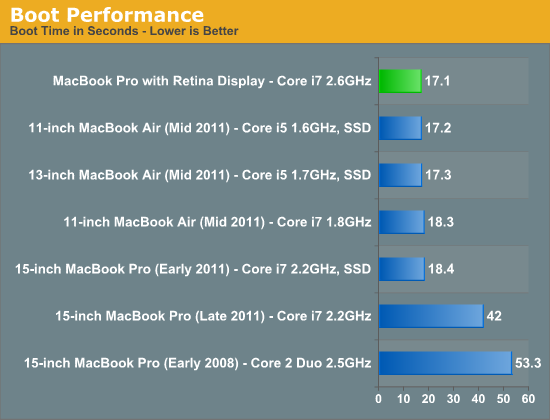
The Retina MBP behaves more like the 3rd gen MacBook Air in how it goes to sleep and wakes up. Both happen virtually instantaneously, and if your battery dies while asleep you don’t get the greyed out screen with progress bar as your environment is restored from disk - it just appears, taking a couple of seconds for the clock to update and everything else to come to life. It’s a small but subtle change that tells you the rMBP is in a distinctly different class. Apple’s tight control over firmware and storage interface help it deliver up to 30 days of standby power, a number I’ll really need to verify one of these days.
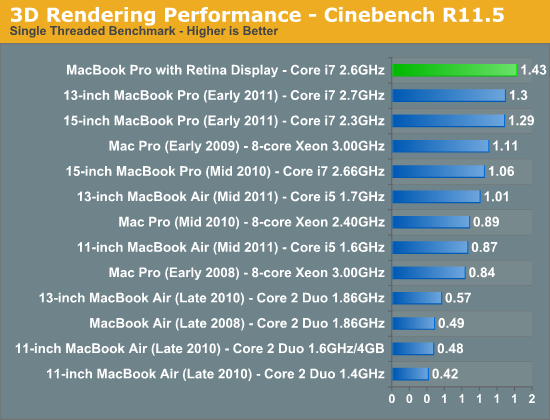
Raw CPU performance is up handsomely over the 2011 MacBook Pros, at least in their standard configurations. The 2.6GHz chip in the $2799 rMBP can turbo up to 3.6GHz when only a single core is active, delivering a 13% increase in performance over the previous generation 2.2GHz part. Compared to the upgraded 2.4GHz Sandy Bridge Core i7 from last year (not pictured) however, I would expect a sub-10% advantage.
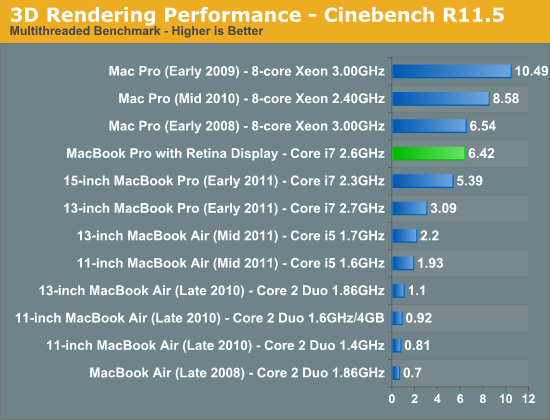
With all four cores active the 2.6GHz chip can run at up to 3.4GHz, which it regularly hits as long as the Kepler GPU stays asleep. The 2.2GHz Sandy Bridge based 2011s we’re comparing to on the other hand can only turbo up to 2.8GHz. Here the advantage is a more tangible 19%, although once again if you are comparing to one of the 2.4GHz parts from last year I would expect notably smaller gains (mid to high single digit percentages). The improved thermal characteristics may allow mobile Ivy Bridge to operate in turbo modes for longer than Sandy Bridge, however I don’t have any data to actually support that claim. That doesn’t mean it can’t happen, it’s just complex to test and model.
While the Cinebench tests are largely CPU bound, many of the following tests are largely influenced by the SSD in the Retina MacBook Pro. Here we see some huge gains, especially compared to older HDD based Macs.
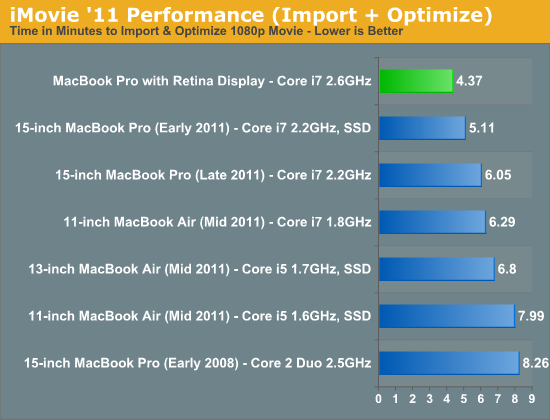
iMovie import time is heavily influenced by disk as well as CPU performance. As a result there are big improvements over both the HDD and SSD equipped 2011 MBPs.

Export time is more heavily CPU bound and here the advantage over the previous generation notebooks is pretty much nonexistent.
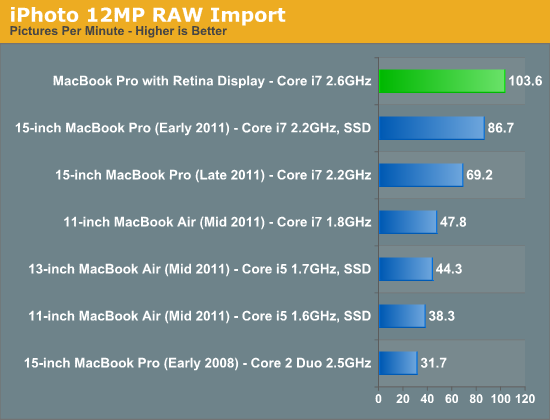
Our iPhoto import test stresses both disk and CPU, giving the rMBP a tangible advantage compared to the SSD equipped 2011 MBP. None of the dual-core or HDD based Macs stand a chance here.

Our Lightroom test continues the storage/CPU dependencies as only the SSD equipped 2011 MBP is able to come close to the rMBP’s performance. There’s not much of a performance advantage here when you compare similarly equipped systems though. Ivy Bridge may have been a good upgrade from a power standpoint, but it doesn’t tell a significantly different performance story in all cases.
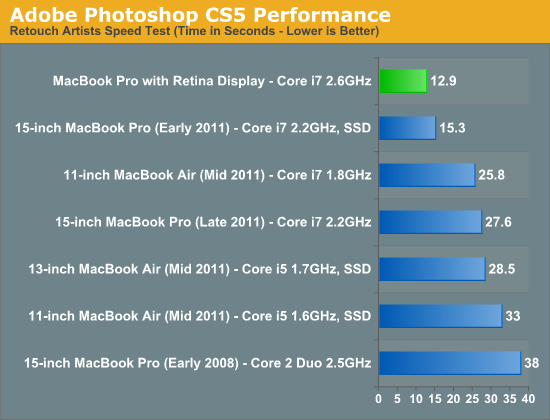
The rMBP cranks through our Photoshop workload fairly quickly. The performance advantages here are likely due to increased memory, a much faster SSD and obvious CPU speed improvements as well.
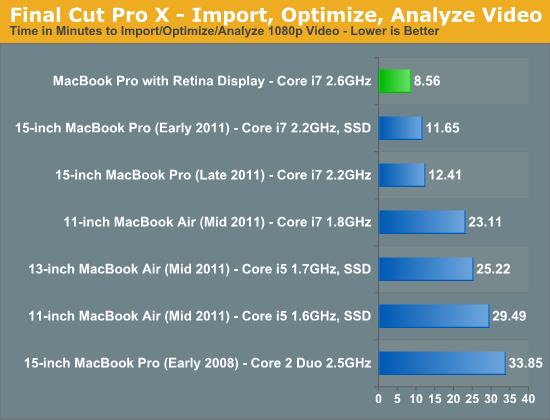
The same holds true for the advantages in our Final Cut Pro X test. As a default configuration the $2799 MacBook Pro with Retina Display is easily the fastest notebook Apple has ever shipped. It’s only if you had an upgraded 2011 model (perhaps with an aftermarket SSD?) that you’ll be unimpressed by the move.
I can’t stress enough how much the new SSD improves the overall experience. It’s just so much faster than what Apple used to ship.










471 Comments
View All Comments
orthorim - Wednesday, June 27, 2012 - link
First of all, PC manufacturers are followers.Second even if they wanted to do it, how are they going to get Microsoft to fully support retina mode? It's evident from the review that Apple's had to do a lot of work on the software side to make it work, and it's still not perfect.
That's Apple's huge advantage: They make hardware and software.
The obstacle for a PC manufacturer would be:
- Get retina displays in quantity (same issue Apple faces - it's doable but by no means easy)
- Get Windows to support retina mode - even if MS were willing, no one knows what amount of effort would be involved. I guess it would be extremely hard to do.
- Get gfx card manufacturers to optimize their drivers to it's fast
All of this takes time and effort...
PubFiction - Friday, August 3, 2012 - link
None of you get it.Super resolution is a by product of OLED. Not of apple, not of anyone else. LG says they can make a panel and apple pays the highest price to have exclusive access fo a while. Are you guys really so stupid that you think apple actually makes these panels?
IF LG does not push IPS displays down in price and up in resolution OLED is quickly going to supplant LCDs as the premium product.
Let me make it clear to the sheeple, PC companies do not give a shit about you or giving you bette stuff until it becomes neccessary to maintain their business, apple happily sold everyone TN panels with low resolution for years while PC makers were offering IPS, wide gamut in work stations laptops.
gorash - Saturday, June 23, 2012 - link
Come on, 1080p screens have existed for some time, and obviously it would move to 4k at some point when it's ready. From the performance standpoint, "Retina" doesn't seem to be all that ready. Maybe in the next year or so, it will be.OCedHrt - Saturday, June 23, 2012 - link
Although the reviewers at Anandtech didn't really like the Z, it is the best laptop I have used to date.solipsism - Saturday, June 23, 2012 - link
Even if Apple can these 27" IPS panels made at a reasonable price and quantity you still have to deal with rending all the pixels in a way that adds more pros than cons.Remember 4k is 4x the pixels of 1080p. Taking the 27" from 2560x1440 to 5120x2880 is going from 3,686,400 px to 14,745,600 px.
DeciusStrabo - Saturday, June 23, 2012 - link
4k isn't 4x the pixels of 1080p. 4k is QFHD, which is 3840x2160 (6.1 million pixels vs. 2 million in 1080p).However, since we already have a spec for 8K (7680x4320 ~ 33 million pixels) things to indeed get interesting soon.
lukarak - Saturday, June 23, 2012 - link
3840x2160 = 8,294,400/
1920x1080 = 2,073,600
--------------------------------
2 x 2 = 4
DanNeely - Saturday, June 23, 2012 - link
4k is a lot more than just quadHD. I wouldn't be surprised if that ends up being the dominant mass market version; but most current 4k cameras record video at 4096x2304/2160.Ohhmaagawd - Saturday, June 23, 2012 - link
"emember 4k is 4x the pixels of 1080p. Taking the 27" from 2560x1440 to 5120x2880 is going from 3,686,400 px to 14,745,600 px."I really doubt it needs to double to be "retina".
Not sure what the sweet spot is, but my gut is somewhere around 3500-4000 pixels wide.
Acanthus - Saturday, June 23, 2012 - link
Apple and their forward looking business sense = buying every factory in the world that can produce high dpi displays. (Yes, they really did that)Anticompetitive =/= "forward thinking"